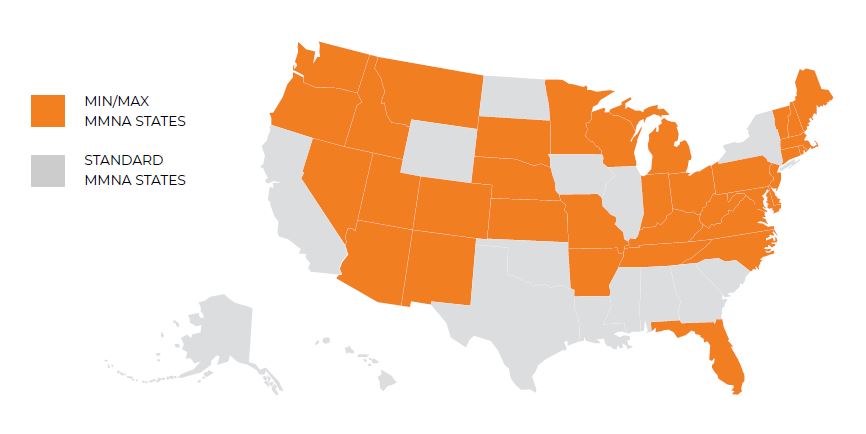Many married couples who are looking to qualify for Medicaid are concerned about the financial well-being of the healthy spouse. To combat this concern, the Medicaid program contains certain standards to prevent spousal impoverishment and allow the spouse at home to maintain their current lifestyle within the community. This includes the Monthly Maintenance Needs Allowance.
Read More: How to Calculate the Community Spouse Resource Allowance for Medicaid
What Is the Monthly Maintenance Needs Allowance?
The Monthly Maintenance Needs Allowance (MMNA) is the amount of income the community spouse is entitled to. If the community spouse’s income is less than their MMNA, they will receive an income shift of the difference, dollar for dollar, from the institutionalized spouse. Some states apply a standard MMNA for cases involving a married couple, while other states apply a minimum and maximum MMNA.

Standard MMNA Calculation
In standard MMNA states, if the community spouse’s income is more than the MMNA, they will continue receiving their income as usual. And if their income is less than the MMNA, they will receive an income shift of the difference from the institutionalized spouse. This amount varies by state and is typically updated annually. For example, if the MMNA is $3,948, and the community spouse’s monthly income is $2,500, they are entitled to receive an income shift of $1,448 from the institutionalized spouse.
Read More: Medicaid Compliant Annuity Strategies for Married Couples
Minimum/Maximum MMNA Calculation
In minimum/maximum MMNA states, the community spouse’s MMNA is based on their total shelter expenses. They will always be entitled to receive at least the minimum, but they may be eligible to receive more if they have shelter expenses above a certain threshold, not to exceed the maximum. The minimum and maximum MMNAs vary by state and are typically updated manually.
To calculate the MMNA in a minimum/maximum MMNA state, you’ll need the community spouse’s total monthly shelter expenses, including the state-specific Standard Utility Allowance, as well as the Shelter Standard.
The Standard Utility Allowance is a standard figure used to represent the community spouse’s monthly utility bills (electricity, water, gas, heat, etc.). Since utility bills can vary each month, the Standard Utility Allowance is used as an estimated amount, rather than calculating the actual out-of-pocket utility costs each month. This allowance varies by state.
The Shelter Standard is a base figure for all the community spouse’s monthly shelter expenses (mortgage payments, real estate taxes, Standard Utility Allowance, etc.). If their total expenses exceed the Shelter Standard, their MMNA is increased dollar-for-dollar from the minimum MMNA to account for the difference, not to exceed the maximum. The Shelter Standard varies by state and is typically updated annually.
Min/Max MMNA Example
George recently became eligible for Medicaid, and his wife Hannah has a monthly income of $2,100, which isn’t enough to cover her monthly shelter expenses. What is Hannah’s MMNA? How much will she receive from George each month?
-
- To calculate Hannah’s MMNA, start by adding up her total monthly shelter expenses, including her state-specific Standard Utility Allowance of $450.
Mortgage Payment: $1,200
Real Estate Taxes: $300
Homeowner’s Insurance: $100
Standard Utility Allowance: $450
Total Monthly Expenses: $2,050
- Next, subtract the Shelter Standard, which is $766.50 in this case, from Hannah’s total monthly shelter expenses of $2,050. The resulting figure of $1,283.50 is the excess expenses Hannah is responsible for each month.
- Then, add the excess expenses to the minimum MMNA, which is $2,555. Since the resulting figure of $4,038.50 is greater than the maximum MMNA of $3,948, Hannah is entitled to the maximum MMNA.
- Finally, to determine Hannah’s income shift from George, subtract her monthly income of $2,300 from her MMNA of $3,948. Hannah is entitled to receive $1,648 from George to supplement her monthly income and maintain her lifestyle within the community.
If you have any questions regarding Medicaid’s spousal impoverishment standards or calculating the MMNA, please book a call with us!